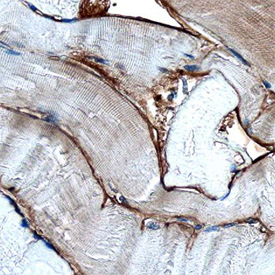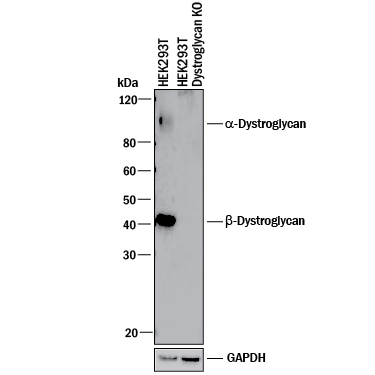Human Dystroglycan Antibody Summary
Gln28-Val749
Accession # Q14118
Applications
Please Note: Optimal dilutions should be determined by each laboratory for each application. General Protocols are available in the Technical Information section on our website.
Scientific Data
 View Larger
View Larger
Detection of Human Dystroglycan by Western Blot. Western blot shows lysates of MCF-7 human breast cancer cell line, SH-SY5Y human neuroblastoma cell line, human muscle tissue, and human placenta tissue. PVDF membrane was probed with 1 µg/mL of Sheep Anti-Human Dystroglycan Antigen Affinity-purified Polyclonal Antibody (Catalog # AF6868) followed by HRP-conjugated Anti-Sheep IgG Secondary Antibody (Catalog # HAF016). Specific bands were detected for a-Dystroglycan at approximately 100-160 kDa (as indicated) and beta -Dystroglycan at approximately 42-44 kDa (as indicated). This experiment was conducted under reducing conditions and using Immunoblot Buffer Group 1.
 View Larger
View Larger
Dystroglycan in Human Skeletal Muscle. Dystroglycan was detected in immersion fixed paraffin-embedded sections of human skeletal muscle using Sheep Anti-Human Dystroglycan Antigen Affinity-purified Polyclonal Antibody (Catalog # AF6868) at 3 µg/mL overnight at 4 °C. Before incubation with the primary antibody, tissue was subjected to heat-induced epitope retrieval using Antigen Retrieval Reagent-Basic (Catalog # CTS013). Tissue was stained using the Anti-Sheep HRP-DAB Cell & Tissue Staining Kit (brown; Catalog # CTS019) and counterstained with hematoxylin (blue). Specific staining was localized to basement membrane. View our protocol for Chromogenic IHC Staining of Paraffin-embedded Tissue Sections.
 View Larger
View Larger
Western Blot Shows Human Dystroglycan Specificity by Using Knockout Cell Line. Western blot shows lysates of HEK293T human embryonic kidney parental cell line and Dystroglycan knockout HEK293T cell line (KO). PVDF membrane was probed with 1 µg/mL of Sheep Anti-Human Dystroglycan Antigen Affinity-purified Polyclonal Antibody (Catalog # AF6868) followed by HRP-conjugated Anti-Sheep IgG Secondary Antibody (Catalog # HAF016). Specific bands were detected for a--Dystroglycan at approximately 110 kDa -and beta -Dystroglycan at approximately 42 kDa (as indicated) in the parental HEK293T cell line, but is not detectable in knockout HEK293T cell line. GAPDH (Catalog # AF5718) is shown as a loading control. This experiment was conducted under reducing conditions and using Immunoblot Buffer Group 1.
Reconstitution Calculator
Preparation and Storage
- 12 months from date of receipt, -20 to -70 °C as supplied.
- 1 month, 2 to 8 °C under sterile conditions after reconstitution.
- 6 months, -20 to -70 °C under sterile conditions after reconstitution.
Background: Dystroglycan
Dystroglycan, also DAG-1 (Dystrophin-associated glycoprotein 1) is a 180-200 kDa heterodimeric adhesion molecule that links the cell cytoskeleton to the extracellular matrix. It is found on skeletal muscle, cardiac muscle, fibroblasts, smooth muscle and keratinocytes. DAG-1 binds multiple matrix molecules, including laminin-1 and -2, agrin, and perlecan. Intracellularly, the cytoplasmic tail of DAG-1 contributes to a large 400 kDa complex that interacts with the cytoskeleton. The human DAG-1 preprocursor is a type I transmembrane protein 895 amino acids (aa) in length. It contains a 27 aa signal sequence plus an 868 aa proform that undergoes autocatalysis to generate a 626 aa alpha -chain (aa 28-653), and a 242 aa beta -chain. Mature DAG-1 is a heterodimer composed of noncovalently linked alpha ‑ and beta ‑chains. The alpha -chain possesses one potential Ig-like domain (aa 64-162), a mucin-like region (aa 316-485), and a peptidase S72 domain (aa 500-733). It is O‑glycosylated and runs from 100-160 kDa in SDS-PAGE. The beta -chain is N-glycosylated and runs at 42-44 kDa in SDS-Page. It possesses a short 95 aa extracellular region (aa 654-749) plus a 120 aa cytoplasmic domain (aa 776-895). Membrane cleavage of the beta -chain causes dissociation of the heterodimer and generates a 30 kDa truncated form. Over aa 28-749, human DAG-1 shares 93% aa identity with mouse DAG-1.
Product Datasheets
Citations for Human Dystroglycan Antibody
R&D Systems personnel manually curate a database that contains references using R&D Systems products. The data collected includes not only links to publications in PubMed, but also provides information about sample types, species, and experimental conditions.
8
Citations: Showing 1 - 8
Filter your results:
Filter by:
-
Deep mutational scanning reveals functional constraints and antigenic variability of Lassa virus glycoprotein complex
Authors: Carr, CR;Crawford, KHD;Murphy, M;Galloway, JG;Haddox, HK;Matsen, FA;Andersen, KG;King, NP;Bloom, JD;
bioRxiv : the preprint server for biology
Species: Human hepegivirus
Sample Types: Whole Cells, Transfected Whole Cells
Applications: Flow Cytometry -
Impact of Hypermannosylation on the Structure and Functionality of the ER and the Golgi Complex
Authors: P Franzka, SC Schüler, T Kentache, R Storm, A Bock, I Katona, J Weis, K Buder, C Kaether, CA Hübner
Biomedicines, 2023-01-06;11(1):.
Species: Mouse
Sample Types: Cell Lysate
Applications: Western Blot -
Cancer Malignancy Is Correlated with Upregulation of PCYT2-Mediated Glycerol Phosphate Modification of alpha-Dystroglycan
Authors: F Umezawa, M Natsume, S Fukusada, K Nakajima, F Yamasaki, H Kawashima, CW Kuo, KH Khoo, T Shimura, H Yagi, K Kato
International Journal of Molecular Sciences, 2022-06-15;23(12):.
Species: Human
Sample Types: Cell Lysates
Applications: Western Blot -
Short-term treatment of golden retriever muscular dystrophy (GRMD) dogs with rAAVrh74.MHCK7.GALGT2 induces muscle glycosylation and utrophin expression but has no significant effect on muscle strength
Authors: PT Martin, DA Zygmunt, A Ashbrook, S Hamilton, D Packer, SM Birch, AK Bettis, CJ Balog-Alva, LJ Guo, PP Nghiem, JN Kornegay
PLoS ONE, 2021-03-26;16(3):e0248721.
Species: Canine
Sample Types: Whole Tissue
Applications: IHC -
Ribitol enhances matriglycan of &alpha-dystroglycan in breast cancer cells without affecting cell growth
Authors: PJ Lu, JD Tucker, EK Branch, F Guo, AR Blaeser, QL Lu
Sci Rep, 2020-03-18;10(1):4935.
Species: Human
Sample Types: Cell Lysates
Applications: Western Blot -
biAb Mediated Restoration of the Linkage between Dystroglycan and Laminin-211 as a Therapeutic Approach for alpha-Dystroglycanopathies
Authors: N Gumlaw, LM Sevigny, H Zhao, Z Luo, DS Bangari, E Masterjohn, Y Chen, B McDonald, M Magnay, T Travaline, T Yoshida-Mo, W Fan, D Reczek, JE Stefano, H Qiu, C Beil, C Lange, E Rao, M Lukason, E Barry, WH Brondyk, Y Zhu, SH Cheng
Mol. Ther., 2019-12-06;0(0):.
Species: Human
Sample Types: Cell Culture Supernates
Applications: Western Blot -
Ribitol restores functionally glycosylated ?-dystroglycan and improves muscle function in dystrophic FKRP-mutant mice
Authors: MP Cataldi, P Lu, A Blaeser, QL Lu
Nat Commun, 2018-08-27;9(1):3448.
Species: Mouse
Sample Types: Tissue Homogenates
Applications: Western Blot -
Structural basis of laminin binding to the LARGE glycans on dystroglycan
Nat Chem Biol, 2016-08-15;0(0):.
Species: Rabbit
Sample Types: Protein
Applications: Western Blot
FAQs
No product specific FAQs exist for this product, however you may
View all Antibody FAQsReviews for Human Dystroglycan Antibody
There are currently no reviews for this product. Be the first to review Human Dystroglycan Antibody and earn rewards!
Have you used Human Dystroglycan Antibody?
Submit a review and receive an Amazon gift card.
$25/€18/£15/$25CAN/¥75 Yuan/¥1250 Yen for a review with an image
$10/€7/£6/$10 CAD/¥70 Yuan/¥1110 Yen for a review without an image



